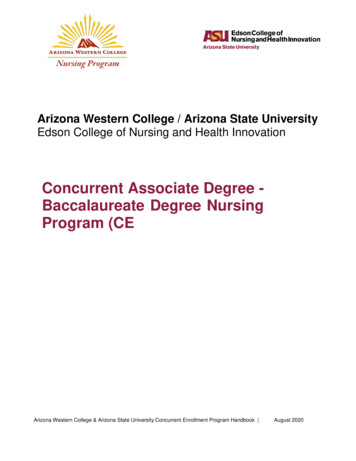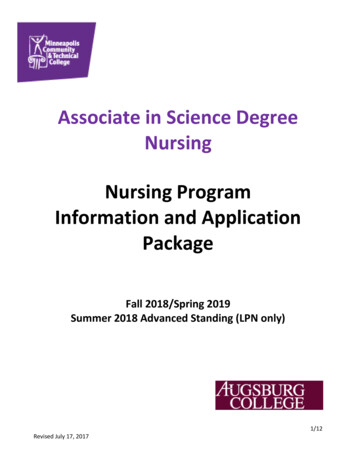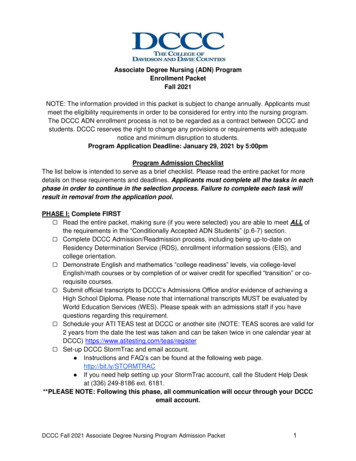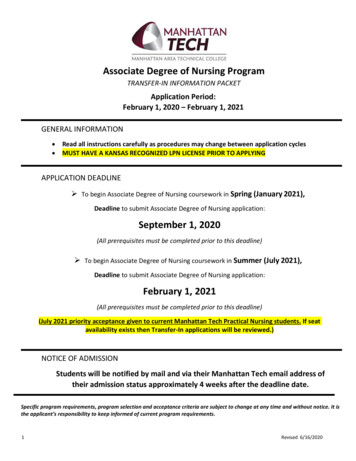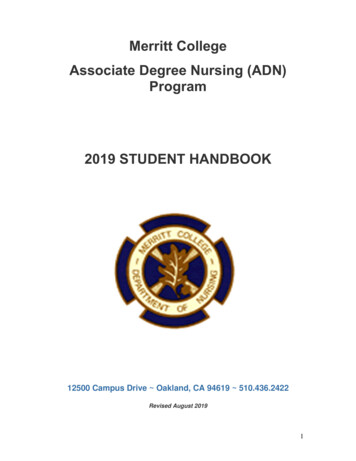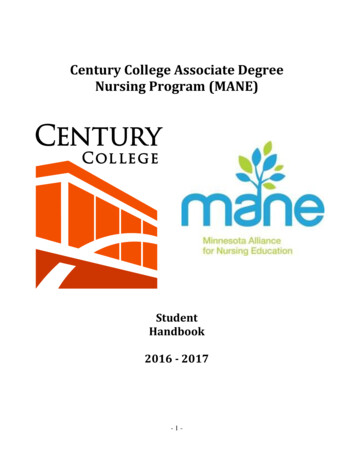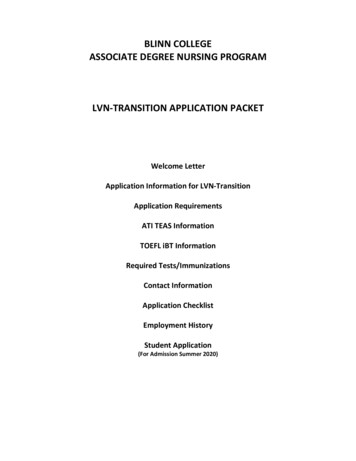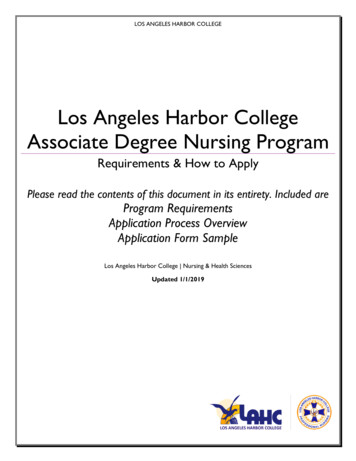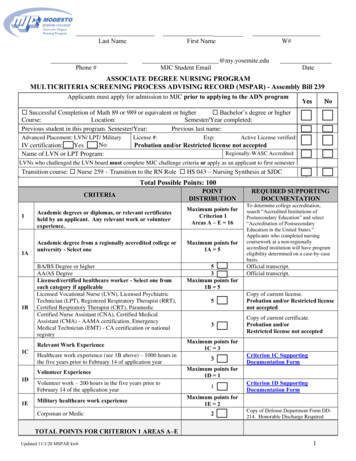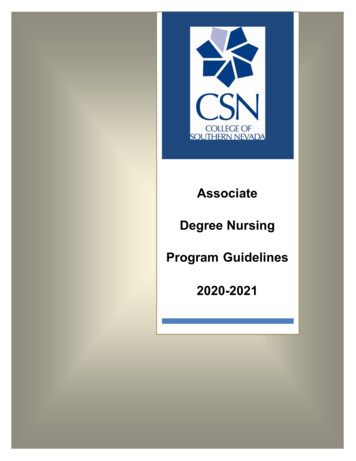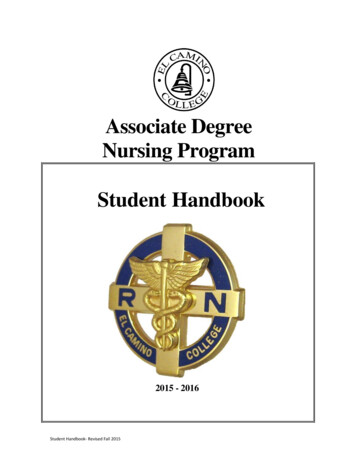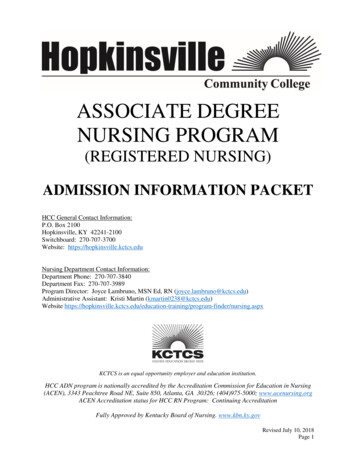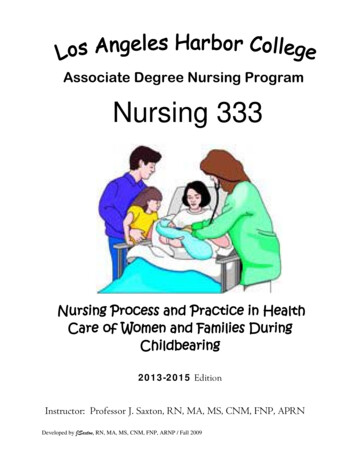
Transcription
Associate Degree Nursing ProgramNursing 333Nursing Process and Practice in HealthCare of Women and Families DuringChildbearing2013-2015 EditionInstructor: Professor J. Saxton, RN, MA, MS, CNM, FNP, APRNDeveloped by JSaxton, RN, MA, MS, CNM, FNP, ARNP / Fall 2009
Course InstructorTable of ContentsCourse Faculty and Contact Information . . 1Catalog Description . 1Credit/Contact Hours . 1Transferability . . 1Prerequisites . 1Student Learning Outcomes/Competencies . . . 1Course Outcomes . 2Required Textbooks . 3Recommended Textbooks . 4Required Clinic Guide . 4Supplies . . 4Uniforms 4Course Policies .4Clinical Eligibility . 4Plagiarism . 5Attendance Policy . 5Math Test Policy . 5Kaplan Testing Policy . . 5Remediation Readmission Policy . . 5Course Credit Challenging Policy . 6College and Department Policies . 7Board Policies/Accommodations . 7Course Grading . . 7Unit Exams and Assignments . . 7Course Grading . 7Critical Outcomes . 8Learning Resources 8Method of Instruction 8Study Time 8Evaluation Method 8Course Units:Unit I - Postpartum Care . 10Unit II - The Newborn . . . 14Unit III - Labor and Delivery . 18Unit IV - Antepartum Care 22i
1Nursing Process and Practice in the Health Care of Women andFamilies During ChildbearingFaculty: Professor J. Saxton, RN, MA, MS, CNM, FNP, APRNContact Information: Office #120Office hours: Monday 1000-1200Phone: (310) 233-4381saxtonj@lahc.eduCatalog Description: Students experience includes both theory and practice in meeting the healthcare needs of women, and of families during childbearing. Psychosocial as well as physiologicalnursing concepts, including cultural, emotional, developmental and environmental areemphasized. Settings include hospitals, clinics and parent education classes.Credit/Contact Hours: This is a 3-unit 6-week course (including final). There are 30 hours oflecture and 81 hours of clinical laboratory.Days & Time: Lecture : Monday: 0800-1005Thursday: 0900-1140Lab: 1140-1210Room: TBAClinic: Tuesday: 0630-1500Wednesday: 0630-1130orTuesday or Sunday: 0630-1930Childbirth Education Class: TBAConcurrent enrollment in N318 is strongly recommended.N318 meets Monday 1510-1715Transferability: ConditionalPrerequisites: Completion of all program prerequisites and a grade of “C” or better in all firstyear Nursing Program courses or admission through the Advanced Placement LVN to RN route,and a grade of “C” or better in Anatomy 1, Physiology 1, Microbiology 1 or 20, Psychology 1,Psychology 41 and English 101. Advanced placement LVN to RN students must complete N311,N321 and transition courses N329A & 329B. Transfer students and other advance placementstudents must meet eligibility requirements for 3rd semester determined by the Retention/Readmission/Transfer/ Challenge (RRT&C) Committee.Student Learning Outcomes/Competencies: At this level, which comprises courses in the thirdsemester of the nursing program, students are expected to continue to apply and adapt medicalsurgical nursing concepts to patients across the life span in a variety of community based healthcare settings, modify plan of care and make decisions for patients at a variety of developmentalstages on the basis of general guidelines or principles derived from previous experiences, organizeand prioritize nursing interventions with supervision, and use appropriate resources to assist insolving patient problems. The student can adapt to different age groups basic skills and developsnew skills applying guidelines that are based on cues from experts. They attempt to correlate andbuild on medical surgical theory and practice. Objectives for this level are:1. Apply the nursing process to individuals and groups across the lifespan and in developmental
22.3.4.5.6.7.8.stages.Display professional behavior standards of nursing practice.Integrate therapeutic communication skills verbally, non-verbally, and in writing.Demonstrate clinical decision making that is accurate and safe and that moves the patient andfamily towards positive outcomes across the lifespan and in various developmental stages.Create caring interventions that assist patients in meeting their bio-psycho-social needs acrossthe lifespan and in various developmental stages.Appraise and display teaching and learning processes to promote health and reduce risks forthe patient and family across the lifespan and in various developmental stages.Practice providing care as part of an interdisciplinary team to delivery patient-centered careto the patient and family across the lifespan and in various developmental stages.Assist patients across the lifespan in a variety of health care settings in the community towardpositive outcomes.Course Outcomes: At the end of this course, with appropriate study and practice in theclassroom, campus-learning laboratory and hospital settings, the third semester student nurse willin relationshipto the Student Learning Outcomes Level 3, #1-8 be able to achieve the following outcomes:1. Utilizes a scientific body of knowledge, critical thinking, nursing process and the RoyAdaptation model to promote adaptation of women and their families during childbearingand interconception in the physiological modes: nutrition ,oxygenation, activity and rest, fluidand electrolytes, elimination, endocrine regulation, protection, sensory, neurological.[1,3,4,5,6]2. Utilizes a scientific body of knowledge, critical thinking, nursing process and the RoyAdaptation model to promote adaptation of women and their families during childbearingand interconception in the psychosocial modes: self concept, role function andinterdependence. [1,3,4,5,6,]3. Develops individualized care plans based on appropriate identification of the nursingdiagnosis, formulation of goals with measurable outcomes, developmental tasks,physiological needs and psychosocial needs reflective of assessment findings. [1,3,8]4. Implements therapeutic nursing interventions to promote optimal health of women andinfants that follow national, federal, state standards and guidelines as established in nursingprotocols. [1,3,5,6]5. Demonstrates culturally sensitive care and applies cultural negotiation and human sexualityduring childbearing and interconception based on the patient’s developmental stage. [1,3,5]6. Assesses, plans and implements teaching plans for women and families based on short rangegoals that provide information and support to rehabilitate, restore and maintain health.[1,3,5,6]7. Evaluates the effectiveness of interventions, communication and teaching in achieving goals.Modifies and revises plans of care as indicated. [1,4,6,7]8. Implements evidence-based practice by integrating theoretical and clinical knowledge withthe best evidence currently available from systematic research, for clinical decision making,to provide the most consistent and best care to patients. [2,4,5,7]9. Communicates and records assessments of patients and care given. Synchronizes care withhealth care team, verbally reports to team and documents patient care findings. [2,3,7]10. Demonstrates computer literacy in accessing information from the internet related to coursecontent, clinical preparation and patient management. Searches professional women’s health
311.12.13.14.15.16.17.18.sites, medical sites and professional organizations for biophysiological, pathophysiologicaland psychosocial responses to illness and adaptation of women and families duringchildbearing and interconception. [2,4,5,7,8]Demonstrates proficiency with previously learned skills and competent skill acquisition ofnew procedures related to patients during childbearing (antepartum, intrapartum, postpartum,newborn) and interconception as follows: [1,2,3,4,5,6,7,8] Leopold Maneuvers Application of external fetal monitor; assist with application of internal fetal monitor Interpretation of fetal monitor strips Physical assessment for the intrapartum patient Physical assessment for the postpartum patient Saline lock conversion Deep tendon reflexes (DTRs) Monitoring clonus Physical assessment for the newborn patient Newborn gavage feeding Newborn heel stick Newborn eye prophylaxis Newborn vitamin K injection Newborn hepatitis B vaccine injection Phototherapy Bulb suctioning the newborn Newborn CPRPrioritizes the care of 2 mother/baby couplets, 2 antepartum patients, and 2 gynecologicalpatients when assigned. Prioritizes sequence of care when assigned to intrapartumpatient(s). [1,4,6,8]Demonstrates competent time management in completing care of assigned patients in thetime allotted. [8]Utilizes additional resources and seeks assistance from the instructor and members ofthe health care team, in a timely manner, when the student encounters a situation thatexceeds the student’s level of knowledge and experience. [2,3,7]Practices within the ethical and legal boundaries of the profession of nursing, agencies andcollege. [2,3,4]Demonstrates correct implementation of the National Patient Safety Goals per agency andschool policy. [2,3,7,8]Assumes responsibility and accountability for own nursing actions. [2,8]Meets professional responsibilities including appropriate grooming, punctuality, initiativeand dependability. [2]Required Textbooks:Murray, S. S. & McKinny, E.S. (2010). Foundations of maternal-newborn and women’s healthnursing (5th ed.). St. Louis, MO: Saunders Elsevier.Lewis, L. L., Dirksen, S. R., et al (2011). Medical-surgical nursing: Assessment andmanagement of clinical problems (8th ed.). St. Louis, MO: Mosby Elsevier.
4Seo-Cho, J. (2000). Nursing process manual: Assessment tool for the roy adaptationmodel. Glendale, CA: Polaris Publishing Company.Potter, P. A. & Perry, A. G. (2009). Clinical nursing skills and techniques (7th ed.). St.Louis, MO: Mosby Elsevier.Green, C. J. (2012). Maternal newborn nursing care plans (2nd ed). Burlington, MA: Jones &Bartlett.Davis’s drug guide for nurses (current edition). F. A. Davis: Philadelphia (or current drug text ofchoice).Los Angeles Harbor College Associate Degree Nursing Program. (current edition). StudentHandbook. Wilmington, CA: AuthorRecommended Textbooks:Pickar, G. D. (2011). Dosage calculations: A ratio proportion approach (3rd Ed.). New York:Delmar.orPickar, G. D. (2008). Dosage calculations (8th Ed.). New York: Delmar.Roy, Sr. C. (2009). The roy adaptation model (3rd ed.). Upper Saddle River, NJ: Pearson.Taber’s cyclopedic medical dictionary or Mosby’s dictionary for medical, nursing and alliedhealth (current edition)Diagnostic/Laboratory text of choiceRequired Clinic Guide:Little Company of Mary Hospital Clinic GuideorTorrance Memorial Medical Center Clinic GuideSupplies: Scantron answer sheets (100 item) for tests x 5Uniforms: See Nursing Program Student HandbookCourse PoliciesClinical Eligibility: To be eligible for clinical attendance all students are required to have thefollowing:a. American Heart Association Cardiopulmonary Resuscitation (CPR) course.Course must be 8-hour course, which includes adult, infant and child CPR andAutomated External Defibrillator (AED).b. First Aid Certificationc. Background check clearanced. A negative TB skin test (2 part process) or chest X-ray within the last year
5e. Positive titers for rubella, varicella, rubeola, and Hepatitis B. Student must followup negative titers with additional immunizations and titers.f. Current flu shotg. Physical examination within the past two years.h. OSHA certification (blood borne pathogens and TB) and required hospital testsi. Fit “mask” testingj. Current personal liability malpractice insurance for the period of time that thestudent will be participating in the course.k. Official written results of all laboratory, x-ray and TB skin test results must be inhealth packetIn addition, all agency required tests must be completed and submitted to clinical instructor. Forcomplete Clinical Requirements see Student Handbook. For specific hospital requirements, seerequired Clinic Guide for assigned facility.Any behavior by a student that puts the patient in jeopardy or is life-threatening will beterminated from the course with a failing grade.Plagiarism and any form of academic dishonesty is not tolerated within the Los AngelesCommunity College District and will result in a zero for the assignment in question and a possibleone to two day suspension from the class (in most cases this will result in a failure for the course).Attendance Policy: Class absences are not to exceed one lecture. If the student is ill or has anemergency, please contact lead instructor as soon as possible. Clinical hours cannot be missed.Nursing students are urged NOT to be absent and are reminded that the student is responsible forALL information, announcements, learning materials given and completion of all work assigned inclass during class time. Three tardies will be counted as one absence (8 week courses). Twotardies will be counted as one absence (6 week courses). Absence that exceeds specified maximummay result in exclusion from the course or receiving an “F” grade.Math Test Policy: The student must pass a basic math test with 90% accuracy. The student willhave two opportunities to pass the exam. A calculator may be used. If the student is unable topass the math exam with 90% after two tries, she/he will not be able to meet course objectives andwill have the option to withdraw from the course or continue and receive a failing grade.Kaplan Testing Policy: Each student will take the required course Kaplan test at the end of thecourse. Each student is required to pay the required test fee by the end of the first week of thecourse when contacted by Kaplan by e-mail. One point will be earned for meeting the benchmarklevel for the specified Kaplan test per course, 2 points is earned if student scored 5% above thebenchmark level, 3 points is earned if student scored 10% above the benchmark level. *In order toreceive additional points from Kaplan integrated test, student MUST be in passing status (75% orgreater). Please Note: Students do not pay Kaplan fee by deadline will not be able to take theKaplan test. Students who do not take the Kaplan test will be given an “Incomplete” for thecourse and will not be able to proceed to the next course.Remediation Readmission Policy: If a student fails to complete this course with a passing grade,including exiting the course before completion by exclusion or withdrawal, the student is required
6to complete an Exit Interview with the clinical instructor or lead instructor and the nursingremediation counselor. It is the student’s responsibility to officially withdraw from the course inAdmissions. To be readmitted to the program, the student must complete a RRT&C request formand submit the form to the Department’s Administrative Secretary. The student request will beconsidered by the RRT&C Committee and readmission will be determined by eligibility of currentadmission policies, number of previous exits, completion of any required remediation andavailable space.Any student who does not pass the required math test after two tries must complete the Accu-calccomputer program in the Nursing Learning Lab and any additional required math remediationprescribed by instructor as stated on the individual plan for return. Contact department nursingcounselor for assistance with Accu-calc computer program. The student must providedocumentation of completion before being readmitted to the nursing program.Any student who has taken the N333 final exam who has failed the course and is requestingreadmission into N333 must show proof of the following remediation before she/he will beconsidered for readmission into N333:a. Successful completion of all remediation prescribed by instructor as stated on theindividual plan for returnAny student who has not taken the N333 final exam who has failed the course and is requestingreadmission into N333 must show proof of the following remediation before she/he will beconsidered for readmission into N333:a. Successful completion of all remediation prescribed by instructor as stated on theindividual plan for returnReadmission to the program is not automatic; students must complete the program in a timelymanner. Students out of the program for two or more semesters may be asked to do remediationwork and/or repeat prior courses completed.A student may enroll in a required nursing class a maximum of two times. A student who takesN333 and receives a grade of “C” or less may not repeat N333 a second time.Please refer to the Student Handbook (current edition) for the RRT&C Policy and Procedure forthis course.Course Credit Challenging Policy: See Nursing Program Student Handbook (current edition)The student who satisfies the Los Angeles Harbor College requirements for receiving Credit byExamination is eligible to challenge Nursing 333 course and clinical requirements by:1. Achieving 90% or higher on a math test2. Achieving a minimal score of 75% for each of the course unit exams and final examination(on first attempt)3. Achieving a satisfactory performance rating for unit procedures4. Achieving 80% or higher on the Postpartum and Newborn AssessmentThe student is expected to complete all Course Syllabus reading materials and activities inpreparation for the exam.
7College and Department Policies: See College Catalog and Nursing Program Student Handbook(current edition). Please note: An addendum for a new category “Course Materials and StudentResponsibility” will appear in the Class Schedule for the 2012 fall tern, pp.13 and 100 citing anaddendum to the 2012-2014 Catalog, p. 8:“To ensure student success, it is necessary for the student to have access to the requiredcourse materials. If the student does not have the access to instructional materialsrequired for the course by the instructor by the end of the third week of the term, theinstructor may exclude the student from the course.”Board Policies/Accommodations:1. Nursing students requiring special accommodations in a course must present officialdocumentation of the type of accommodations required to the nursing faculty.2. Board Rule 9803.12. Dishonesty, such as cheating, or knowingly furnishing falseinformation to the college. Examples of academic dishonesty: A student copies fromanother student, to help an academically weaker student by providing answers to a test orusing "crib" notes.3. Board Rule 9803.14. Obstruction or disruption of classes, administration, disciplinaryprocedures, or authorized College activities.4. Board Rule 9803.19. Alcohol and Drugs. Any possession of controlled substances whichwould constitute a violation of Health and Safety Code section 11350 or Business andProfessional Code section 4230, any use of controlled substance the possession ofwhich are prohibited by the same, or any possession or use of alcoholic beverages.Please see college catalog for a listing of all District Board Rules. Also, refer to the StudentDiscipline Procedure for due process for disciplinary issues, grievances and the student appealproc
Prerequisites: Completion of all program prerequisites and a grade of “C” or better in all first year Nursing Program courses or admission through the Advanced Placement LVN to RN route, and a grade of “C” or b
